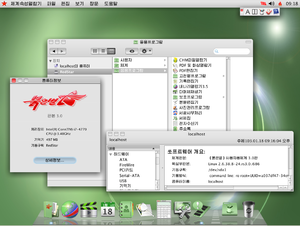Red Star OS
| Red Star OS | |
|---|---|

|
|
 Screenshot of the desktop of the Red Star OS |
|
| developer | Korea Computer Center |
| License (s) | Information is missing |
| Current version | 4.0 (2017) |
| ancestry |
GNU / Linux ↳ Red Hat Linux ↳ Fedora ↳ Red Star OS |
| Architecture (s) | i386 (x86) |
| Korean spelling | |
|---|---|
| Korean alphabet : | 붉은 별 |
| Revised Romanization : | Bulgeunbyeol |
| McCune-Reischauer : | Pulgŭnbyŏl |
The Red Star OS (Korean: 붉은 별; MR : Pulgŭnbyŏl; German “ Red Star Operating System ”) is a Linux distribution that was developed in North Korea from 2002 in order to no longer depend on the English-language Windows versions used up until then to be. The current version 4.0 has been available in Korean since 2017.
Specifications
Red Star OS includes a modified Mozilla browser called Naenara , which allows access to the North Korean intranet ( Kwangmyong ). Some other pre-installed programs are a text editor , picture viewer , e-mail program , media player , packer and some computer games . The operating system has its own keyboard layout for Korean (does not correspond to the Windows version), English, Russian, Chinese and Japanese.
In the versions prior to version 3, the operating system used a KDE 3 desktop environment with elements similar to the Microsoft Windows XP operating system . Version 3.0 uses KDE 4 and RsDock as a dock . The preset theme is an imitation of Apple's macOS operating system .
The installation DVD is available in North Korea for the equivalent of 25 US cents.
Monitoring functions
The two German IT scientists Florian Grunow and Niklaus Schiess examined Red Star OS in detail and presented their results in 2015 at the 32nd Chaos Communication Congress of the Chaos Computer Club . After their analyzes, they found that although there is no monitoring mechanism built into the operating system that gives government officials direct access to the computer, it is possible that any backdoors are only imported via updates. There is, however, a function that provides every file opened with the operating system with a watermark , which is generated using the hard disk serial number. If the file is opened on several computers, several unique serial numbers accumulate, which can be used to determine the distribution path of the file. A supposed anti-virus program is also integrated , but it is more used to delete files as soon as it finds a certain text pattern. The operating system also protects itself against manipulation by monitoring a list of the checksums of system files and restarting the computer in the event of a discrepancy.
Vulnerabilities
In 2016, the security company Hacker House found a security hole in the integrated Naenara web browser . This security gap makes it possible to execute commands on the computer if the user clicks on an appropriately prepared link. It probably occurs due to a problem in the processing of URls, in which functions such as Mailto or cal are executed without cleaning up unwanted code fragments from the passed parameters .
Web links
- 32C3: Red Star OS - an operating system for a dictatorship , Heise Online, December 28, 2015
Individual evidence
- ^ Joseph Cox: Inside North Korea's Totalitarian Operating System. In: Motherboard . VICE , December 27, 2015, accessed December 28, 2015 .
- ↑ Red Star OS: North Korea clones Windows and OS X. (No longer available online.) In: Chip Online . March 4, 2014, archived from the original on May 1, 2015 ; accessed on May 6, 2015 . Info: The archive link was inserted automatically and has not yet been checked. Please check the original and archive link according to the instructions and then remove this notice.
- ↑ North Korea's “secret cyber-weapon”: brand new Red Star OS. In: Russia Today . March 8, 2010, accessed January 23, 2013 .
- ↑ Apple's Mac OSX imitated in the latest North Korea system. In: BBC News . February 5, 2014, accessed March 24, 2014 .
- ^ Matthew Sparkes: North Korean computers get 'Apple' makeover. In: The Daily Telegraph . February 5, 2014, accessed February 6, 2014 .
- ^ Jörg Thoma: A visit to North Korea's computer science students. In: golem.de . December 30, 2014, accessed May 6, 2015 .
- ↑ Markus Böhm: Operating system from Pyongyang: This is how North Korea's Apple copy works. In: Spiegel Online . December 27, 2015, accessed December 29, 2015 .
- ↑ Red Star OS: Security hole in North Korea's state Linux - Golem.de . ( golem.de [accessed December 6, 2016]).